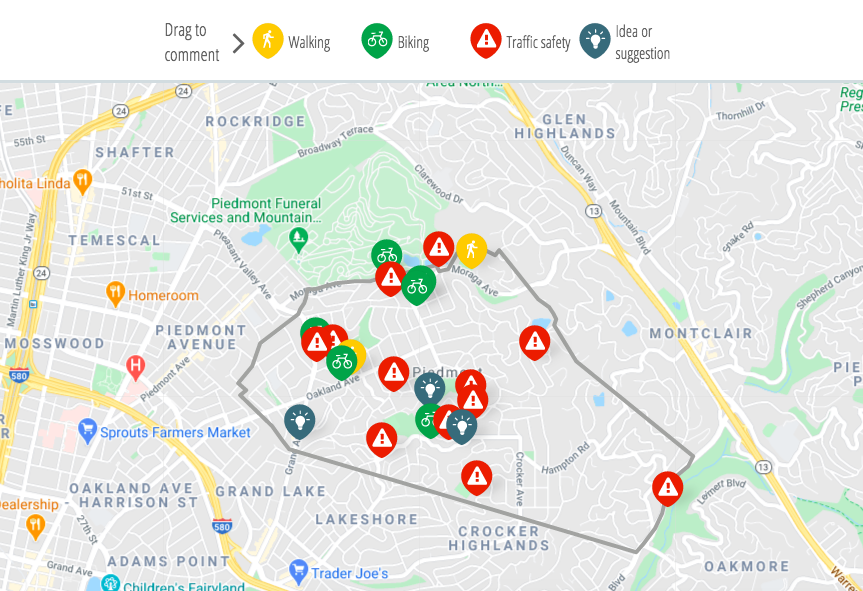The city recently gathered input from residents on the needs and challenges around walking, biking and traffic safety in Piedmont. From Nov. 2020 – Jan. 2021, residents were invited to share thoughts via a survey, a pinnable map, a public workshop, and via the Safer Streets website. The report said the city received more than 2,500 comments from the public as part of the community needs assessment.
A report summarizing the key issues and themes raised by the public is now available HERE. and was presented at the Pedestrian and Bicycle Advisory Committee on Thursday, Feb. 11.
In a note on the Piedmont Safer Streets website, the city says the project team is now using the feedback to develop the recommendations under the Piedmont Safer Streets plan and will update again in two months.
Page 17 of the assessment summarizes key findings:
“The main concern expressed by commenters, perhaps by a large margin, is speeding traffic. Speeding is foremost a safety issue, especially for pedestrians and cyclists, who are more vulnerable users of the streets, but also for drivers. Speeding also has a corrosive effect on general neighborhood livability. Commenters’ suggestions for curbing speeding ranged widely, including physical traffic calming measures, educational campaigns, stop signs, lower speed limits and more police enforcement.
Specific to walking, the main concern, by far, is challenging crossing conditions for pedestrians at intersections. These conditions include poorly
marked crosswalks; the need for additional stop signs, crosswalks, bulbouts and street lighting; poor sight lines and visibility; and speeding drivers and drivers failing to yield to pedestrians. A secondary walking-related concern is gaps in sidewalk coverage and existing sidewalks in poor condition.
Regarding biking, the main need—other than addressing speeding—is to fill in gaps in the bikeway network, with segments of Moraga Avenue being among the most important gaps.
There are very mixed feelings regarding the Grand Avenue road diet. The project has improved safety for bicyclists and also pedestrians but causes back-ups, delays and spillover traffic onto adjacent streets.
Similarly, there are mixed feelings regarding recently installed low-cost intersection improvements, such as at Grand and Fairview Avenues and at Nova Drive/Magnolia Avenue. These enhancements slow down traffic and
make it easier for pedestrians to cross but are considered confusing and visually unattractive by many.
Another specific concern is inadequate visibility and sight lines at many locations throughout the city. Contributing factors include street curves,
on-street parking close to intersections, overgrown vegetation and inadequate nighttime street lighting.”

The report summarizes “key issues and concerns” but also key solutions. Top among them is speed humps – see page 10 of the report. A speed hump is a lesser speed bump. Speeds humps were supported by 75% of respondents which dovetails with the survey concerns about speeding in town. Hopefully speed humps will be a principal element of the new plan.
Strangely, Piedmont has opposed effective speed bumps while Piedmont is surrounded by Oakland which uses them. I’ve never seen evidence that speed bumps create a liability problem for the city. Yet Piedmont resists using effective speed bumps. They work much better than the weaker speed humps like on Linda. Boulevard Way goes through Oakland and Piedmont. The Oakland stretch toward Lakeshore has a speed bump. I invite interested parties to try driving over it and see how effective it is.
Good point Michael – there has been resistance to speed bumps in Piedmont for years, largely from city administration from my experience on Council. And you raise an important distinction – the Linda speed hump, in a school zone, is associated with a significant crosswalk infrastructure – drivers are alerted to slow down by several factors. Out in the neighborhoods where no infrastructure is found, maybe bumps are needed to achieve the needed speed reduction. Hopefully the consultant and city staff will address your points at the next Safer Streets meeting in April.
Thanks Garrett, your response does raise the question of how does a city policy get established and persist for decades when a councilmember or possibly more than one may not be supportive.
Hello, l have reached out to many Rose Avenue residents and received over 15 email responses with many people requesting a Stop sign at the top of Echo. Other spots are of residents’s concerns as well, such as speeding and blind spots that make driving here dangerous.
I would like to share the emails I have gathered so far with the City of Piedmont.
Please reach out to me as soon as possible.
Thank you so much!